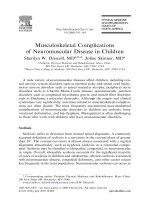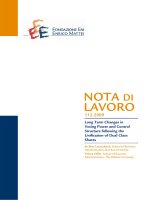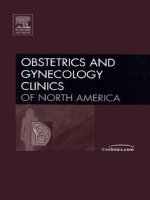AHA GI complications of dual antiplatelets statement 2006
Bạn đang xem bản rút gọn của tài liệu. Xem và tải ngay bản đầy đủ của tài liệu tại đây (107.74 KB, 4 trang )
CLINICIAN UPDATE
CLINICIAN UPDATE
Gastrointestinal Complications of Dual Antiplatelet Therapy
Neelima G. Vallurupalli, MD; Samuel Z. Goldhaber, MD
C
ase presentation: A 59-yearold man with a history of hypertension, dyslipidemia, and
smoking was hospitalized with acute
coronary syndrome requiring emergency percutaneous coronary intervention with 4 drug-eluting stents. His
discharge medications included dual
antiplatelet therapy with aspirin 325
mg/d and clopidogrel 75 mg/d. Three
weeks after discharge, he returned to
the Emergency Department with
bloody stools and a hematocrit of 23%
(previously 36%) and required 3 U of
packed red blood cells. Endoscopy
showed a bleeding duodenal ulcer with
adherent clot (Figure).
Background
We prescribe dual antiplatelet therapy
with aspirin and clopidogrel to prevent
and treat cardiovascular, cerebrovascular, and peripheral arterial disease. According to American Heart Association statistics, 700 000 patients had
stroke, 13 million had coronary artery
disease, and 8 to 12 million suffered
from peripheral arterial disease in
2002. Each year, 1.2 million patients in
the United States receive dual antiplatelet therapy with aspirin and clopidogrel after percutaneous coronary intervention with drug-eluting stents.
The number of patients in the United
States who receive dual antiplatelet
therapy for various vascular conditions
such as coronary artery disease, transient ischemic attack, thrombotic
stroke, and peripheral vascular disease
probably exceeds several million.
The use of aspirin compared with
placebo reduces the risk of myocardial
infarction, stroke, or death from vascular causes by Ϸ25%.1 In the Clopidogrel Versus Aspirin in Patients at
Risk of Ischemic Events (CAPRIE)
trial, administration of clopidogrel decreased the relative risk of vascular
events by 8.7% compared with aspirin.2 The addition of clopidogrel to
aspirin in patients with acute coronary
syndrome reduces the risk of reinfarction, stroke, and death by 20% compared with aspirin alone.3
The net benefit from using dual
antiplatelet therapy in high-risk vascular disease patients comes at the cost of
increased gastrointestinal (GI) complications. Major complications include
gastroduodenal ulcerations that can
lead to GI hemorrhage, perforation,
and death. Minor complications include dyspepsia, pill esophagitis, subepithelial hemorrhages, erosions, and
ulcerations in the stomach and duodenum. Patients at especially high risk
for GI complications while on antiplatelet therapy are the elderly; those
with a history of gastroduodenal ulcers, gastroesophageal reflux disease,
esophagitis, untreated Helicobacter
pylori infection, intestinal polyps, or
cancer; and those using concomitant
anticoagulants, steroids, or nonsteroidal anti-inflammatory drugs.
Risk of GI Complications
With Aspirin
The suppression of gastroduodenal
mucosal prostaglandin synthesis is one
of the important mechanisms of mucosal damage by aspirin.4 Serious GI
ulcer complications are 2- to 4-fold
more common in patients who take 75
to 300 mg/d of aspirin compared with
controls.5,6 Aspirin doses as low as 10
mg/d can significantly decrease the
gastric mucosal prostaglandin level
and cause gastric erosions.7 During a
4-year period in the United Kingdom
Transient Ischemic Attack study, GI
complications in patients taking aspirin ranged from mild dyspepsia (31%)
to life-threatening bleeding and perforation (3%).8
While examining the relationship
between aspirin intake and hospitalization with peptic ulcer bleeding, Weil et
al5 found that all doses of aspirin are
associated with an increased risk of GI
bleeding. The risk of GI bleeding was
dose related: odds ratio 2.3 for 75
mg/d, 3.2 for 150 mg/d, and 3.9 for
300 mg/d. The risk of upper GI bleeding for plain, enteric-coated, or buff-
From the Cardiovascular Division, Brigham and Women’s Hospital, Harvard Medical School, Boston, Mass.
Correspondence to Samuel Z. Goldhaber, MD, Cardiovascular Division, Brigham and Women’s Hospital, 75 Francis St, Boston, MA 02115. E-mail
(Circulation. 2006;113:e655-e658.)
© 2006 American Heart Association, Inc.
Circulation is available at
DOI: 10.1161/CIRCULATIONAHA.105.590612
e655
e656
Circulation
March 28, 2006
Endoscopic image of bleeding duodenal ulcer with clot on top. This image was taken in
a patient with a history similar to that of our patient. Arrow points to the base of duodenal ulcer with active bleeding. Picture contributed by Sarathchandra Reddy, MD, and
Edwin Chun Ouyang, MD, PhD, Division of Gastroenterology, Brigham and Women’s
Hospital, Boston, Mass.
ered aspirin did not differ.9 Long-term
aspirin therapy, even at a low dose (50
to 162.5 mg/d), may cause overt GI
bleeding.10
Risk of GI Complications
With Clopidogrel
It is unclear how clopidogrel causes GI
erosions or ulcerations. Clopidogrel
has no effect on the cyclooxygenase
pathway and therefore acts independently of aspirin. In a retrospective
analysis, the frequency of GI bleeding
in a high-risk population with prior
peptic ulcer disease was 12%.11
Risk of GI Complications
With Dual Antiplatelet
Therapy
The risk of overt GI bleeding with dual
antiplatelet therapy can be as high as
1.3% within the first 30 days of therapy.3 In the Clopidogrel for Unstable
Angina to Prevent Recurrent Events
(CURE) study, Peters et al12 showed
that the risk of bleeding increases with
increasing dose of aspirin with or without clopidogrel. The dose of clopidogrel remained fixed at 75 mg/d. At
the highest dose of aspirin (Ն200 mg)
given with placebo, bleeding was
higher (3.7%) than the risk of GI
bleeding with the combination of clopidogrel and aspirin in the lowest-dose
(Յ100 mg) group (3.0%).
Efficacy of Dual Antiplatelet
Therapy
Drug-eluting stents have become the
standard of care for percutaneous coronary intervention to reduce the risk of
in-stent restenosis. However, in-stent
thrombosis, a catastrophic and potentially fatal complication, may occur
more often with drug-eluting than bare
metal stents. The strongest predictor of
stent thrombosis is discontinuation of
antiplatelet therapy, exceeding other
independent predictors such as renal
failure, bifurcation lesions, diabetes,
and low ejection fraction.13 Hence,
after percutaneous coronary intervention with drug-eluting stents, aspirin is
prescribed lifelong and clopidogrel is
prescribed for at least 3 months.14
However, McFadden et al15 reported 4
cases of late stent thrombosis occurring as late as 442 days after implantation of drug-eluting stents and resulting in myocardial infarction when
antiplatelet therapy was discontinued.
Late thrombosis seen with drugeluting stents is attributed to delayed
vascular healing and delayed re-endothelialization, rendering the stent prothrombotic. Some cardiologists continue patients on antiplatelet therapy
indefinitely if no adverse bleeding
events are encountered.
Aspirin and clopidogrel “resistance”
has been increasingly identified with
the availability of point-of-care platelet aggregation tests. Many patients on
aspirin and clopidogrel therapy do not
achieve the desired level of platelet
inhibition. One way to overcome aspirin and clopidogrel resistance is to use
higher loading and maintenance doses.
The inhibition of platelet aggregation by clopidogrel is dose dependent.
A higher loading dose of clopidogrel is
now being used more often than the
conventional 300-mg dose because of
more rapid and higher levels of platelet
inhibition. Patti et al16 reported that a
600-mg loading dose was safe and
more effective in reducing periprocedural infarction than a 300-mg loading
dose.
Monitoring and Diagnosis of
GI Complications
Several methods can be used to monitor and diagnose occult and overt GI
complications of dual antiplatelet therapy. The tests range from least specific
(fecal occult blood test) to the gold
standard of traditional endoscopy. Patients can also be monitored for clinical symptoms such as dyspepsia or
bloating by using a symptom diary or a
validated scoring system similar to the
Gastrointestinal Symptoms Rating
Scale questionnaire (Table).
A noninvasive imaging test that
does not require sedation to diagnose
occult GI complications is the PillCam
ESO capsule endoscopy (Given Imag-
Vallurupalli and Goldhaber
Complications of Antiplatelet Therapy
Gastrointestinal Symptom Rating Scale: A Validated Rating Scale of GI Symptoms in
Patients With Peptic Ulcer Disease
Abdominal pain syndrome
Epigastric pain
Colicky pain
Dull pain
Undefined pain
Patients are asked to rate subjective symptoms associated
with each syndrome from 0 to 3* on the basis of severity,
frequency, duration, and need for antacids for relief of
symptoms. The sum of the scores for all items for
abdominal pain syndrome and dyspeptic syndrome is the
GSRS total score for peptic ulcer disease. The higher the
overall score, the more severe are the symptoms.
Dyspeptic syndrome
Epigastric pain
Heartburn
Acid regurgitation
Sucking sensation in the epigastrium
Nausea and vomiting
GSRS indicates Gastrointestinal Symptom Rating Scale.
*0ϭNo symptoms; 1ϭoccasional episode for short duration; 2ϭfrequent and prolonged episodes;
3ϭsevere continuous episodes. The minimum score is 0, and a maximum score is 27 for peptic ulcer
disease.
ing, Inc, Norcross, Ga). The disposable, ingestible PillCam ESO endoscope is an 11ϫ26-mm capsule. It
acquires video images from both ends
of the device during passage through
the esophagus. The capsule transmits
the acquired images via a digital radiofrequency communication channel to
an external data recorder unit. On completion of the examination, the accumulated data are processed with image
reconstruction and are interpreted by a
GI specialist. The PillCam is excreted
in the feces and does not need to be
retrieved.
Is GI Prophylaxis Needed for
Dual Antiplatelet Therapy?
Patients on dual antiplatelet therapy
can develop both upper and lower GI
bleeding. GI hemorrhage is associated
with an increased mortality rate, a
greater need for surgery, blood transfusions, a prolonged length of hospital
stay, and increased overall healthcare
costs. Although upper GI bleeding can
be prevented with appropriate prophylaxis, there is no effective prophylaxis
for lower GI bleeding.
Prophylactic acid-suppressive therapy is beneficial in the prevention of
upper GI complications. Two major
classes of protective agents are (1) H2
antagonists and (2) proton pump inhibitors (PPIs).
H2 antagonists reversibly block H2
receptors on the basolateral membrane
of gastric parietal cells.17 Until the
early 1990s, H2 antagonists were the
mainstay of pharmacotherapy for the
prevention and management of upper
GI bleeding. Between 1984 and 2000,
32 randomized controlled trials compared H2 antagonists with placebo.18
Agents evaluated in these studies included cimetidine, ranitidine, and famotidine. Many were limited by a
small sample size and unsatisfactory
study design.
Factors limiting the utility of H2
antagonists include the development of
tachyphylaxis, the need for dosage adjustment in renal insufficiency, and
side effects such as thrombocytopenia
and mental status abnormalities.
The introduction of PPIs has led to a
safer and more effective strategy in the
prevention and management of GI ulceration.17 PPIs irreversibly inhibit hydrogen ion pumps in gastric parietal
cells. PPIs block the final step of acid
production, negate stimulation of gastric secretion, and lead to prolonged
acid suppression.
Yeomans et al19 showed that omeprazole, a PPI, is more effective than
H2 receptor antagonists in suppressing
gastric acid, preventing ulcers, and
healing ulcers that are related to
chronic use of nonsteroidal antiinflammatory drugs such as aspirin.
e657
Chan et al20 randomized 320 patients with vascular disease who had
previous GI bleeding while taking aspirin to clopidogrel alone versus aspirin plus esomeprazole. The cumulative
incidence of recurrent ulcer bleeding
over a 12-month period in this study
was 8.6% in patients who received
clopidogrel and 0.7% in patients who
received aspirin and esomeprazole.
Is it justifiable to start all patients
requiring dual antiplatelet therapy on
prophylactic acid-suppressive therapy?
The risk of an adverse GI event in
antiplatelet users depends on the patient’s baseline risk, added risk associated with the dose and duration of
aspirin and clopidogrel therapy, and
protection conferred by cotherapy with
acid-suppressive agents. Physicians
who prescribe antiplatelet therapy
should be aware of an individual patient’s risk of GI complications. During every office visit, physicians
should ask about new or worsening GI
symptoms. Initiating prophylactic
acid-suppressive therapy may be reasonable in high-risk patients for the
duration of antiplatelet therapy; however, clinical trials are urgently needed
to confirm or refute this hypothesis.
Patients who undergo PCI for acute
coronary syndrome are usually discharged on 5 classes of medications:
aspirin, clopidogrel, a -blocker, an
angiotensin-converting enzyme inhibitor, and a statin. These medications
reduced the morbidity and mortality
rates in large-scale randomized controlled trials. Before subjecting PCI
patients to a routine prophylactic acidsuppressive therapy as the sixth standard medication, we need large-scale
trials to assess cost-effectiveness and
to determine whether the benefit outweighs the risks of polypharmacy.
Case
Our patient represents a frequent clinical scenario that physicians often encounter in their practice. Given his
multiple risk factors and the recent
implantation of 4 drug-eluting stents,
he should receive indefinite antiplatelet therapy. Although antiplatelet
e658
Circulation
March 28, 2006
agents were stopped for 1 day during
the upper GI bleeding, they were resumed immediately when active bleeding stopped. He was discharged home
on a PPI along with antiplatelet
therapy.
References
1. Antiplatelet Trialists’ Collaboration. Collaborative overview of randomized trials of
antiplatelet therapy, I: prevention of death,
myocardial infarction, and stroke by prolonged antiplatelet therapy in various categories of patients. BMJ. 1994;308:81–106.
2. CAPRIE Steering Committee. A randomized, blinded, trial of Clopidogrel
Versus Aspirin in Patients at Risk of
Ischaemic Events (CAPRIE). Lancet. 1996;
348:1329 –1339.
3. Yusuf S, Zhao F, Mehta SR, Chrolavicius S,
Tognoni G, Fox KK. Effects of clopidogrel
in addition to aspirin in patients with acute
coronary syndromes without ST-segment
elevation. N Engl J Med. 2001;345:494 –502.
4. Cohen MM, MacDonald WC. Mechanism of
aspirin injury to human gastroduodenal
mucosa. Prostaglandins Leukot Med. 1982;
9:241–255.
5. Weil J, Colin-Jones D, Langman M, Lawson
D, Logan R, Murphy M, Rawlins M, Vessey
M, Wainwright P. Prophylactic aspirin and
risk of peptic ulcer bleeding. BMJ. 1995;310:
827– 830.
6. Sorensen HT, Mellemkjaer L, Blot WJ,
Nielsen GL, Steffensen FH, McLaughlin JK,
Olsen JH. Risk of upper gastrointestinal
bleeding associated with use of low-dose
aspirin. Am J Gastroenterol. 2000;95:
2218 –2224.
7. Cryer B, Feldman M. Effects of very low
dose daily, long-term aspirin therapy on
gastric, duodenal, and rectal prostaglandin
levels and on mucosal injury in healthy
humans. Gastroenterology. 1999;117:17–25.
8. Farrell B, Godwin J, Richards S, Warlow C.
The United Kingdom Transient Ischaemic
Attack (UK-TIA) aspirin trial: final results.
J Neurol Neurosurg Psychiatry. 1991;54:
1044 –1054.
9. Kelly JP, Kaufman DW, Jurgelon JM, Sheehan
J, Koff RS, Shapiro S. Risk of aspirinassociated major upper-gastrointestinal
bleeding with enteric-coated or buffered product. Lancet. 1996;348:1413–1416.
10. Derry S, Loke YK. Risk of gastrointestinal
haemorrhage with long term use of aspirin:
meta-analysis. BMJ. 2000;321:1183–1187.
11. Ng FH, Wong SY, Chang CM, Chen WH,
Kng C, Lanas AI, Wong BC. High incidence
of clopidogrel-associated gastrointestinal
bleeding in patients with previous peptic
ulcer disease. Aliment Pharmacol Ther.
2003;18:443– 449.
12. Peters RJ, Mehta SR, Fox KA, Zhao F,
Lewis BS, Kopecky SL, Diaz R,
Commerford PJ, Valentin V, Yusuf S.
Effects of aspirin dose when used alone or in
combination with clopidogrel in patients
with acute coronary syndromes: observations from the Clopidogrel in Unstable
Angina to Prevent Recurrent Events (CURE)
study. Circulation. 2003;108:1682–1687.
13. Iakovou I, Schmidt T, Bonizzoni E, Ge L,
Sangiorgi GM, Stankovic G, Airoldi F,
Chieffo A, Montorfano M, Carlino M,
Michev I, Corvaja N, Briguori C, Gerckens
U, Grube E, Colombo A. Incidence, predictors, and outcome of thrombosis after successful implantation of drug-eluting stents.
JAMA. 2005;293:2126 –2130.
14. Antman EM, Anbe DT, Armstrong PW,
Bates ER, Green LA, Hand M, Hochman JS,
Krumholz HM, Kushner FG, Lamas GA,
Mullany CJ, Ornato JP, Pearle DL, Sloan
MA, Smith SC Jr, Alpert JS, Anderson JL,
Faxon DP, Fuster V, Gibbons RJ, Gregoratos
G, Halperin JL, Hiratzka LF, Hunt SA,
Jacobs AK. ACC/AHA guidelines for the
management of patients with ST-elevation
myocardial infarction: a report of the
15.
16.
17.
18.
19.
20.
American College of Cardiology/American
Heart Association Task Force on Practice
Guidelines (Committee to Revise the 1999
Guidelines for the Management of Patients
with Acute Myocardial Infarction). Circulation. 2004;110:e82– e292.
McFadden EP, Stabile E, Regar E,
Cheneau E, Ong AT, Kinnaird T, Suddath
WO, Weissman NJ, Torguson R, Kent
KM, Pichard AD, Satler LF, Waksman R,
Serruys PW. Late thrombosis in drugeluting coronary stents after discontinuation of antiplatelet therapy. Lancet.
2004;364:1519 –1521.
Patti G, Colonna G, Pasceri V, Pepe LL,
Montinaro A, Di Sciascio G. Randomized
trial of high loading dose of clopidogrel for
reduction of periprocedural myocardial
infarction in patients undergoing coronary
intervention: results from the ARMYDA-2
(Antiplatelet therapy for Reduction of MYocardial Damage during Angioplasty) study.
Circulation. 2005;111:2099 –2106.
Rivkin K, Lyakhovetskiy A. Treatment of nonvariceal upper gastrointestinal bleeding.
Am J Health Syst Pharm. 2005;62:1159–1170.
Levine JE, Leontiadis GI, Sharma VK,
Howden CW. Meta-analysis: the efficacy of
intravenous H2-receptor antagonists in
bleeding peptic ulcer. Aliment Pharmacol
Ther. 2002;16:1137–1142.
Yeomans ND, Tulassay Z, Juhasz L, Racz I,
Howard JM, van Rensburg CJ, Swannell AJ,
Hawkey CJ. A comparison of omeprazole
with ranitidine for ulcers associated with
nonsteroidal antiinflammatory drugs: Acid
Suppression Trial: Ranitidine versus Omeprazole for NSAID-Associated Ulcer
Treatment (ASTRONAUT) Study Group.
N Engl J Med. 1998;338:719 –726.
Chan FK, Ching JY, Hung LC, Wong VW,
Leung VK, Kung NN, Hui AJ, Wu JC,
Leung WK, Lee VW, Lee KK, Lee YT, Lau
JY, To KF, Chan HL, Chung SC, Sung JJ.
Clopidogrel versus aspirin and esomeprazole
to prevent recurrent ulcer bleeding. N Engl
J Med. 2005;352:238 –244.









